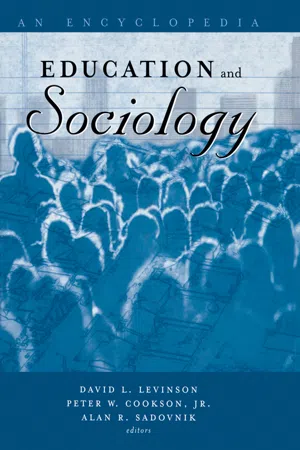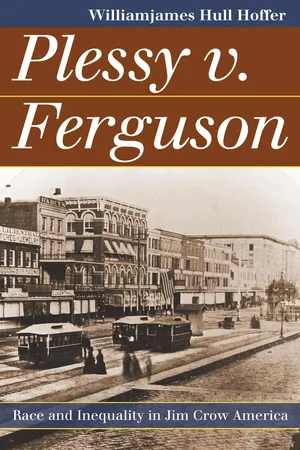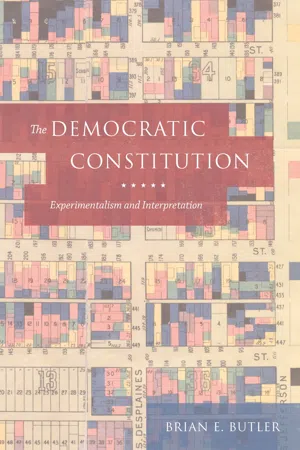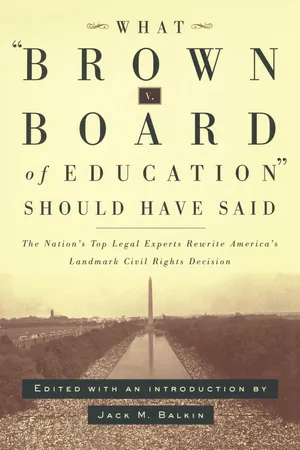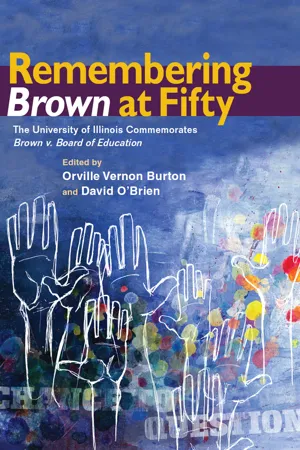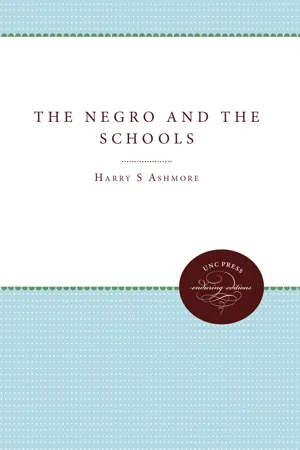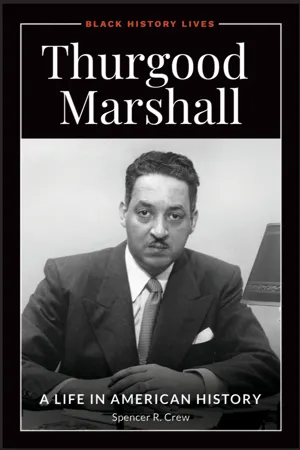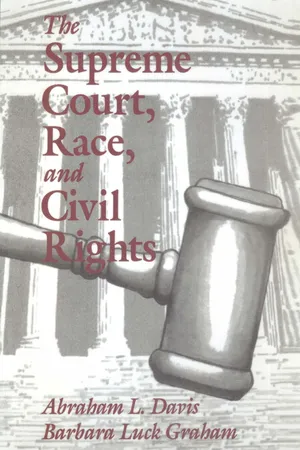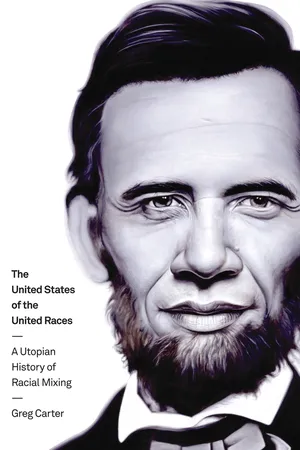History
Plessy vs Ferguson
"Plessy v. Ferguson" was a landmark 1896 Supreme Court case that upheld the constitutionality of racial segregation under the "separate but equal" doctrine. The ruling allowed for segregation in public facilities, setting a precedent for institutionalized racial discrimination. This decision was later overturned by the Supreme Court in the 1954 case Brown v. Board of Education.
Written by Perlego with AI-assistance
Related key terms
Related key terms
1 of 4
Related key terms
1 of 3
12 Key excerpts on "Plessy vs Ferguson"
- eBook - ePub
Landmark Law Cases and American Society
United States v. Price and the Struggle for Civil Rights
- Howard Ball(Author)
- 2017(Publication Date)
- University Press of Kansas(Publisher)
CHAPTER 2 Genesis Mississippi and the Struggle for Racial Equality You don’t understand the fear. There was a great fear, that deep fear we [blacks] had to live with daily. That fear is still strongly among us. It’s never gone away. REVEREND CLINT COLLIER, NESHOBA COUNTY, 1964 The year 1954 was a signal breakthrough one for blacks in their struggle for equality. While long-established civil rights organizations such as the NAACP, created in 1909, had been battling in the courts for equality for blacks, it was a difficult war with modest successes. A prime reason for the continuing dilemma was the enduring vitality of the Plessy doctrine. In Plessy v. Ferguson, 1896, a 7:1 U.S. Supreme Court majority validated state legislation that socially segregated the races. The Court stated that as long as the separated facilities were equal, the Constitution’s Fourteenth Amendment Equal Protection Clause was not offended by such state laws. After all, the Court said, the Tenth Amendment gives to the states the police power to protect the public’s health, safety, welfare, and well-being. And if the community believed that the two races were fundamentally different morally and intellectually, then legislators could pass laws to absolutely segregate these groups. Plessy was the Court’s imprimatur legitimating the separation of the races—ultimately, separation covered all social situations from birth to death. By the beginning of World War I, America’s system of Jim Crow (the term given to formal and informal segregation practices) meant that from hospitals—and doctors, nurses, pharmacies—to cemeteries, and all social matters between, there would be absolute separation - eBook - ePub
Education and Sociology
An Encyclopedia
- David Levinson, Peter Cookson, Alan Sadovnik, David Levinson, Peter Cookson, Alan Sadovnik(Authors)
- 2014(Publication Date)
- Routledge(Publisher)
Brown. The Thirteenth Amendment of 1865 abolished slavery and “involuntary servitude …within the United States, or any place subject to their jurisdiction.” The Fourteenth Amendment followed in 1868, requiring that no state “abridge the privileges … of citizens of the United States.” “It thus ensured that the Thirteenth Amendment (among others) applied within as well as across states. It also (as in the Fifth Amendment) promised “due process of law” and required that states guarantee “equal protection of the laws” to all of their citizens.Over the next quarter century, the Supreme Court narrowed the scope and import of these amendments (along with the Fifteenth, which provided suffrage for male ex-slaves). But it was not until the 1896 decision in Plessy v. Ferguson that the vision of racial equality apparently endorsed by the Civil War amendments was definitively squelched. In its decision on the Civil Rights Cases and the Slaughterhouse Cases in the previous decade, the Court had implicitly allowed private racial discrimination by explicitly forbidding discriminatory acts by state and local governments. In Plessy, the Court removed all but the last barrier to the reinstatement of slavery—the right to buy and sell individuals—by allowing state and local governments to pass whatever laws or ordinances they wished to reinstate white supremacy.Specifically, the Supreme Court found in Plessy that blacks could legitimately be given “equal but separate accommodations” in railroad cars, restaurants, schools, and other public places. Plessy justified this decision by declaring it a “fallacy” to assume “that the enforced separation of the two races stamps the colored race with a badge of inferiority.” The authors of the 7–1 decision further declared that they could “not accept [the] proposition[s] … that social prejudices may be overcome by legislation, and that equal rights cannot be secured to the negro except by an enforced commingling of the two races.”Brown v. Board of Education and its successors eventually overturned, in fact if not in name, the basic holding and all three of the defending propositions of Plessy, but not until severe damage had been inflicted on the nation. In the decade before Plessy, blacks’ rights to vote, hold office, attain an education, buy land, and move had all been eroded since the high point of Reconstruction. But Plessy legitimated and hastened the institutionalization of Jim Crow laws. For example, in 1870, 10% of “Negro and other races” were enrolled in school; by 1880 that percentage had risen dramatically, to 33 percent. Twenty years later, the proportion of blacks enrolled in school had declined slightly, to 31%. (The proportion of whites enrolled in school declined even more dramatically between 1880 and 1900, from 62 to 54%—suggesting that Jim Crow was just as harmful to the apparent “winners” as to the obvious losers.) Between 1882 (the first year for which data are available) and 1890, an average of “only” 69 blacks were lynched each year. Between 1891 and 1900—the Plessy decade—that average jumped to 113 per year. (The average number of whites who were lynched declined, from 76 per year in the first decade to 43 per year in the second.1 ) The number of blacks registered to vote in, for example, Louisiana declined from 130,300 in 1896 (the year that Plessy was decided) to 1,300 in 1904. Other southern states followed suit in prohibiting black suffrage.2 In short, the half century after Plessy - eBook - ePub
Landmark Law Cases and American Society
Race and Inequality in Jim Crow America
- WilliamJames Hull Hoffer(Author)
- 2012(Publication Date)
- University Press of Kansas(Publisher)
chapter 5 __ _____________ __ Plessy ’s World As Brown’s opinion indicates, the law in Plessy represented the currents of contemporary thought. At the same time, it provided the foundation for another round of segregation—this one much more severe than what had preceded it. Plessy rearranged the conversation about segregation from one of legal categories to one of evidence, social science, and psychology. In summary, Plessy gave a window of opportunity for litigants to challenge Jim Crow on the basis of actual inequality of facilities, funding, and treatment. The case law that followed Plessy provides evidence for all of these statements. The first mystery, doctrinally speaking, is how Harlan’s dissent’s phrasing of the doctrine “separate but equal” became generally accepted over the Court’s and the Separate Car Act’s phrase “equal, but separate.” Dissenting opinions have no precedential value. There was no legal reason for Harlan’s phrasing to gain credibility. With only a few exceptions, an examination of the case law after Plessy does not show state legislatures adopting the Harlan formulation either. They either used “equal, but separate” or mandated “separate” facilities and that they be “equal.” But then Associate Justice Charles Evans Hughes accepted the “separate but equal” phrase as an accurate summary of the holding in Plessy in his majority opinion in McCabe v. Atchison, Topeka & Santa Fe Railway Company in 1914. Furthermore, headnotes—the publisher-provided keys to decisions—in the West Law compendiums of cases began to routinely use the “separate but equal” language to describe the provisions of state statutes and the holding of various courts, including the U.S. Supreme Court, whether or not those words appeared in the decisions themselves - eBook - ePub
The Democratic Constitution
Experimentalism and Interpretation
- Brian E. Butler(Author)
- 2017(Publication Date)
- University of Chicago Press(Publisher)
Obergefell in order to see whether and how it could have dealt with the pressing issues they involved.Brown v. Board of Education
Brown overruled the “separate but equal” doctrine found in Plessy v. Ferguson.1 Plessy involved a Louisiana statute had that required railways to separate whites and black passengers and provide “equal but separate accommodations for the white and colored races.” In its opinion, the Court made a distinction between equality before the law and social equality, and then noted that separations between the races have been generally accepted as legitimate under state police power and do not “necessarily imply the inferiority of either race to the other.” Therefore, it continued, “the enforced separation of the races, as applied to the internal commerce of the State, neither abridges the privileges or immunities of the colored man, derives him of his property without due process of law, nor denies him the equal protection of the laws within the meaning of the Fourteenth Amendment.”2 Ultimately the Court found Plessy’s argument that the law denied him proper treatment to be based upon a “fallacy”:We consider the fallacy of the plaintiff’s argument to consist in the assumption that the enforced separation of the two races stamps the colored race with a badge of inferiority. If this be so, it is not by reason of anything found in the act, but solely because the colored race chooses to put that construction upon it. The argument necessarily assumes that if, as has been more than once the case and is not unlikely to be so again, the colored race should become the dominant power in the state legislature, and should enact a law in precisely similar terms, it would relegate the white race to an inferior position. We imagine that the white race, at least, would not acquiesce in that assumption. The argument also assumes that social prejudices may be overcome by legislation, and that equal rights cannot be secured to the negro except by an enforced commingling of the two races. We cannot accept this proposition. If the two races are to meet upon terms of social equality, it must be the results of natural affinities, a mutual appreciation of each other’s merits, and a voluntary consent of individuals.3 - eBook - ePub
What Brown v. Board of Education Should Have Said
The Nation's Top Legal Experts Rewrite America's Landmark Civil Rights Decision
- Jack Balkin(Author)
- 2001(Publication Date)
- NYU Press(Publisher)
I feel this concern most keenly in the apparent unwillingness on the part of several of my fellow Justices to overrule Plessy v. Ferguson outright and generally, not only with respect to public schools but also as to transportation—the context in which it was originally announced—and to other sectors of American life where the separate-but-equal doctrine has dropped deep roots. An authoritative study on race relations reports as follows in this regard: Most other public facilities—such as libraries, parks, playgrounds—are available to Negroes with about the same amount of discrimination in the various regions of the country, as in schools. Negroes are not permitted to use these in the South unless they are acting in a servant capacity. Many Southern cities have separate parks, playgrounds, and libraries for the Negroes, but in all cases they are poor substitutes for those available to whites. Gunnar Myrdal, An American Dilemma 634 (1944). 1 There is, in my estimation, no justification for judicial timidity in this regard. For we know as men and women that until the Plessy doctrine is eliminated “root and branch,” true progress in achieving racial equality will be significantly frustrated and retarded. We have also learned through our own decision-making process that racial segregation practices reinforce, and are in turn reinforced by, numerous official acts of outright denials of constitutionally protected rights on a racially discriminatory basis. This pattern has repeated itself during the 20th century, to cite just a few examples, in the field of housing, Barrows v. Jackson, 346 U.S. 249 (1953) (holding that award by state court of damages against co-covenantor for breach of racially restrictive housing covenant constitutes state action depriving non-Caucasians of equal protection of the laws), Shelley v. Kraemer, 334 U.S - eBook - ePub
Remembering Brown at Fifty
The University of Illinois Commemorates Brown v. Board of Education
- Orville Vernon Burton, David O'Brien, Orville Vernon Burton, David O'Brien(Authors)
- 2022(Publication Date)
- University of Illinois Press(Publisher)
Board and related cases was not to overturn the “separate but equal” doctrine in Plessy, but to raise its costs: to make it too expensive for whites to endure by compelling cities, counties, and states to make “equal” expenditures on schools for blacks. The state of Texas allocated one hundred thousand dollars to build an entirely new law school for blacks rather than admit a fully qualified black applicant into the state-supported, all-white University of Texas Law School that admitted only whites. The Supreme Court ruled in that case, Sweatt v. Painter, that even if the new black law school built for Sweatt equaled the UT Law School in the quality of its physical plant and equipment (itself a doubtful assumption), that Sweatt would still be deprived of the learning environment of the white law school, its alumni contacts, and its reputation. 42 In Brown v. Board, the Court unanimously overturned Plessy as the law of the land. Yet as Derrick Bell reminds us, Plessy “is only fortuitously a legal precedent. In actuality, it is a judicial affirmation of an unwritten but no less clearly understood social compact that is older than the Constitution, was incorporated into that document, and has continually been affirmed.” 43 That compact entails a possessive investment in whiteness and protections for the group position of whites in perpetuity, a systematic and structured advantage. 44 In her brilliant analysis of whiteness as property, Cheryl I. Harris explains that both before and after the passage of comprehensive civil rights laws, the U.S. judiciary has honored this compact, recognizing “implicitly or explicitly, the settled expectations of whites built on the privileges and benefits produced by white supremacy.” 45 Even though the Supreme Court disavowed Plessy in 1954, getting around Brown has produced a situation that is even worse: constitutional legitimacy for schools to be both separate and unequal - eBook - ePub
- Harry S. Ashmore(Author)
- 2010(Publication Date)
- The University of North Carolina Press(Publisher)
Plessy doctrine might have been shaken by this litigation it was still standing, and nothing short of a clear-cut decision by the Supreme Court could strike it down.It was also evident that there was no common judicial agreement on the proper remedy for inequalities in a dual school system. In this respect, each of the five cases raised a different question. Could school authorities lawfully be permitted time to provide equal facilities? If so, how much time should they have? On the other hand, assuming that the plaintiffs have a personal and immediate right to relief, how long could they be required to wait for equalization? Where there was no issue but the constitutionality of segregation, was a lower court justified in dismissing the case?The Supreme Court indicated that it had been pondering these and related matters ever since it agreed to joint consideration of the five cases. On June 8, 1953, in calling for further argument, the Court submitted a list of searching questions to opposing counsel.In the first place, the Court wanted to know the views of the litigants on the genesis of the Fourteenth Amendment with reference to bi-racial education—whether or not the Congress which submitted the Fourteenth Amendment and the state legislatures and conventions which approved it understood that it would abolish segregation in the schools. At the December, 1953, hearing counsel for the plaintiffs argued firmly and eloquently that the end of segregation in education was clearly die intent of the framers of the amendment; with equal firmness and eloquence counsel for the defense argued that it was no such thing. The brief submitted on behalf of U. S. Attorney General Brownell rested on the middle ground established by the scholars who had inquired into the subject over the years: - eBook - ePub
Thurgood Marshall
A Life in American History
- Spencer R. Crew(Author)
- 2019(Publication Date)
- ABC-CLIO(Publisher)
A key part of Carter’s case was the testimony of Oliver Brown. During his testimony, Brown described his seven-year-old daughter Linda’s daily travel to Monroe, her segregated school, which was about a mile’s distance from her home. Each day Linda left at 7:40 a.m. to get to school by 9:00 a.m. To catch her school bus by 8:00 a.m., Linda walked a dozen blocks between railroad tracks to the bus stop. Brown pointed out that the bus often came late, which forced her to stand in the rain or snow until it arrived. After a thirty-minute ride, she arrived at the school, where she stood outside as long as thirty minutes waiting for the building to open. In contrast, Sumner, the white school, was only about seven blocks from the Browns’ home, with a much shorter and less dangerous route to travel. But when he sought to enroll Linda at Sumner, the principal denied his request, prompting Brown to join in the suit.The trial lasted for three days, with the lawyers for the school system taking the position that the African-American schools were not inferior and, as such, did not violate separate but equal. They also argued that public opinion in their community supported the maintenance of segregated schools, and it was not the duty of the schools to go against community preferences. After five weeks of deliberation, the district court judges handed down their decision. They found in favor of the Topeka school board. In their judgment, earlier U.S. Supreme Court decisions, such as the McLaurin case, pertained only to graduate and professional schools. The Plessy decision still ruled, and the actions of the school board met the requirements set out by it. At the same time, the judges gave hope to Carter and the NAACP through an attachment to their ruling containing nine “Findings of Fact” related to the case. In five of the facts they gave credence to the psychological argument offered by the NAACP. The last sentence in that finding indicated that the judges accepted the detrimental impact of separate systems: “Segregation with the sanction of law, therefore, has a tendency to retard the educational and mental development of Negro children and to deprive them of some of the benefits they would receive in a racially integrated school system” (Kluger, 2004, p. 424). Marshall and the NAACP saw this statement as a small moral victory. They felt the 1951 ruling of the Kansas judges would place pressure on the U.S. Supreme Court to provide their view on whether Plessy v. Ferguson should stand. Marshall quickly had the appeal of the case sent forward to the U.S. Supreme Court.Meanwhile, in South Carolina, officials filed the six-month report required by the district judges. In it they pointed to progress in providing funding for equalizing school buildings, the purchase of new equipment, upgrades to the curricula at African-American schools, as well as the equalization of teacher salaries. They asserted their commitment to seeing these actions through to completion and asked only for additional time to make them happen. In light of this report, the U.S. Supreme Court, to whom the NAACP had appealed the original decision, directed the lower court to issue a final judgment. It again found in favor of South Carolina. Marshall immediately appealed their decision to the U.S. Supreme Court, asserting that only an end to segregation would meet the immediate needs of their clients. - eBook - ePub
The Supreme Court, Race, and Civil Rights
From Marshall to Rehnquist
- Abraham L. Davis, Barbara Luck Graham(Authors)
- 1995(Publication Date)
- SAGE Publications, Inc(Publisher)
Plessy v. Ferguson, 163 U.S. 537 [1896] is controlling in principle in favor of the judgment of the court below.…… That there exists a serious and difficult problem arising from a feeling of race hostility which the law is powerless to control, and to which it must give measure of consideration, may be freely admitted. But its solution cannot be promoted by depriving citizens of their constitutional rights and privileges.As we have seen, this court has held laws valid which separated the races on the basis of equal accommodations in public conveyances, and courts of high authority have held enactments lawful which provide for separation in the public schools of white and colored pupils where equal privileges are given. But in view of the rights secured by the Fourteenth Amendment to the Federal Constitution such legislation must have its limitations, and cannot be sustained where the exercise of authority exceeds the restraints of the Constitution. We think these limitations are exceeded in laws and ordinances of the character now before us.It is the purpose of such enactments, and, it is frankly avowed it will be their ultimate effect, to require by law, at least in residential districts, the compulsory separation of the races on account of color. Such action is said to be essential to the maintenance of the purity of the races, although it is to be noted in the ordinance under consideration that the employment of colored servants in white families is permitted, and nearby residences of colored persons not coming within the blocks, as defined in the ordinance, are not prohibited.The case presented does not deal with an attempt to prohibit the amalgamation of the races. The right which the ordinance annulled was the civil right of a white man to dispose of his property if he saw fit to do so to a person of color and of a colored person to make such disposition to a white person. - eBook - ePub
The United States of the United Races
A Utopian History of Racial Mixing
- Greg Carter(Author)
- 2013(Publication Date)
- NYU Press(Publisher)
3Plessy v. Racism
Throughout the nineteenth century, the United States’ acquisition of territory incorporated more types of people, complicating the master narrative of white supremacy that the Atlantic colonies established. Interracial encounters occurred in various paradigms, showing that mixture was relevant to more than just blacks and whites. Interracial intimacy with Hispanics, Indians, and Asians tested the borders of inclusion in different ways in the context of white supremacy, just as they do today. Even though the Civil War had ended, legal battles over the meanings of citizenship erupted throughout the Reconstruction era. These proved relevant to all racial minorities, even though the question of emancipation focused primarily on African Americans. Those who argued for an expansion of citizenship for minorities faced a grave defeat with Plessy v. Ferguson , in which the Supreme Court decided the legality of racial segregation in 1896.Set in Louisiana, the principals in this case were people of color with a high degree of mixture in their backgrounds. Because of the state’s French and Spanish colonial past, Louisiana had a different perspective on racial mixing than did most of the United States. The British colonies on the East Coast protected white racial purity by punishing interracial marriage and leaving white male sexual privilege alone. They also promoted endogamy by bringing British women to the colonies soon after their establishment. On the other hand, the French settling Louisiana (much like the Spanish settling Mexico) accepted racial mixing as part of their colonial identity. It took much longer for marriage-able women to arrive, so the original settlers took black and Indian mates. They also privileged white male sexual privilege, but they set up practices that let the existence of their mixed population be more public. Some of their offspring were slaves, but some were free people of color who owned property, enjoyed a higher standard of living, and identified as Francophone just as the French did. This is how the term Creole , which in its strict sense referred to European settlers born in the colonies, came to refer to the polyglot of European, African, and indigenous descent in New Orleans. Since the nineteenth century, Louisianians concealing the racial mixture in the region’s past have inscribed a white-only meaning to the term Creole , attempting to make its meaning refer only to the French and Spanish settlers in Louisiana. But, as in colonial Mexico, those Europeans immediately began mixing with the black and Indian women around them, and Creole implied mixture by definition. The free people of color acknowledged their mixture, considering themselves a separate, mixed group rather than black or white.1 - eBook - ePub
SUNY series in African American Studies
Essays on Derrick Bell's Racial Realism
- Timothy Joseph Golden, Timothy Joseph Golden(Authors)
- 2022(Publication Date)
- SUNY Press(Publisher)
In order to make this ruling, however, the overwhelming psychological and sociological data would have had to be taken much more seriously than they were. Indeed, “Counsel for the Negro children have gone to great lengths to prove what must be obvious to every person who gives the matter even cursory attention: With some notable exceptions, schools provided for Negroes in segregated systems are unequal in facilities—often obscenely so.” 66 Forced integration would not change this state of affairs. For when the court mandated integration, according to Bell, it simply replaced the problem of inequality with the problem of outright violence against Blacks, which would perpetuate rather than eliminate the inequality that the Constitution demands. In his re-imagined opinion of the Brown decision, Bell, writing for the Court that would uphold Plessy, writes: Again, it would seem appropriate to declare wrong what is clearly wrong. Given the history of segregation and the substantial reliance placed on our decisions as to its constitutionality, though, a finding by this Court in these cases that state supported racial segregation is an obsolete artifact of a bygone age, one that no longer conforms to the Constitution, will set the stage not for compliance, but for levels of defiance that will prove the antithesis of the equal educational opportunity the petitioners seek. 67 One need only recall the sight of federal troops accompanying school children into white schools to be reminded that such an environment is not conducive to learning. Instead, the inequitable lack of physical resources is replaced with Black children experiencing the terror stemming from the threat of physical violence against them. This is in no way conducive to the sort of educational opportunities that African Americans were seeking. To the contrary, it was profoundly counterproductive. The Supreme Court, of course, did not uphold Plessy and enforce its equal prong - eBook - ePub
Race, Law, and Higher Education in the Colorblind Era
Critical Investigations into Race-Related Supreme Court Disputes
- Hoang Vu Tran(Author)
- 2019(Publication Date)
- Routledge(Publisher)
First, to answer the constitutionality of educational segregation, the Court looks at the text of the amendment to see if it provides any guidance. It does not. The text of section 1 says nothing remotely related to education or segregation. Second, if the text provides no illuminating answers, the Justices will investigate the original intent of the framers of the Fourteenth Amendment. The Justices would ask: did the authors of the Fourteenth Amendment intend for the ‘equal protection clause’ to outlaw segregation in public education? By any stretch of imagination, at the time of the amendment’s adoption, education was mostly a local or regional practice. Finally, the Court looks at the established local practices during the time of the amendment’s ratification. Although many local municipalities had not embarked on the project to provide comprehensive public education, many families, black and white, sent their kids to local parochial and private schools. These schools were located in segregated black and white churches and single building schoolhouses. Particularly in Washington D.C., many of the those who participated in the adoption of the Fourteenth Amendment sent their own kids to white-only schools. Collectively, all three prescribed steps of initial constitutional procedure (text, intent, and established practices) answered the constitutional question of whether or not educational segregation violated the Fourteenth Amendment’s equal protection clause with a clear no. Collectively, the Fourteenth Amendment said nothing about education or segregation, the authors of the amendment surely did not intend for education to be desegregated when they sent their own kids to white-only schools, and established practices at the time did not have a robust public education system.Warren had a clear answer from the text, intent, and established local practices of the Fourteenth Amendment. If Warren’s opinion stayed consistent with the procedural history of the Court, he would have had to uphold Plessy’s constitutional doctrine of ‘separate but equal’ preserving racially segregated schools. The late Chief Justice William Rhenquist agreed with this position, writing in a memo in the early stages of Brown in 1952 as a Supreme Court law clerk. Rhenquist’s memo was written to Justice Robert Jackson, a member of the Brown court. Rhenquist stated that although he was excoriated by liberal colleagues for his unpopular and unhumanitarian position, he believed that Plessy v. Ferguson should not be overturned.Chief Justice Warren signaled a shift away from the established traditions and customs of the Court. Warren was deftly strategic in his opinion on the one hand, to acknowledge the historical procedure of the court, while on the other hand, not allowing the substance of his decision to be completely bound by its procedure. That is, the Chief Justice did not step out and directly say his opinion deviated from hundreds of years of established constitutional procedural practice. Nevertheless, he did just that by declaring in the opinion that in looking at the text, intent, and established practices, ‘these circumstances provided were at best inconclusive’.3
Index pages curate the most relevant extracts from our library of academic textbooks. They’ve been created using an in-house natural language model (NLM), each adding context and meaning to key research topics.
Explore more topic indexes
Explore more topic indexes
1 of 6
Explore more topic indexes
1 of 4

